Store Fronts
What do these photos tell you about the kind of stores and shops that were in these towns?
Telluride Hardware Store
This is the front of the J. D. Work & Company hardware store in Telluride. The photo was taken about 1903.
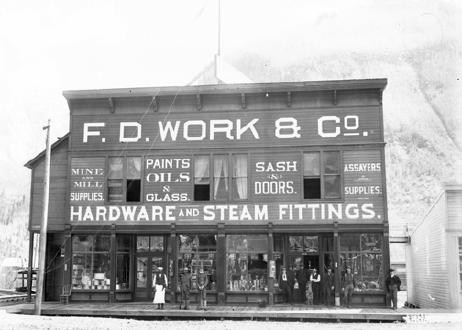
Photo: Denver Public Library, Western History Collection
More About This Topic
Photos of storefronts tell us a lot about mining towns of the 1800s. The owner of this hardware store in Telluride used the front of his store to advertise goods that he sold. What do the advertisements tell us about why miners and mine owners needed hardware stores?
Their Own Words
"In the same block with the Review [a newspaper] were two or three eating houses, two groceries, a hardware store, assay office, a meat market, a drug store, jewelry store, two or three saloons, two dance halls, and perhaps some other places of business."
Source: George A. Root, “Gunnison in the Early ‘Eighties,” Colorado Magazine, 9 (Nov. 1932): 202.
Bon Ton Restaurant In Ouray
This is a photo of the Bon Ton Restaurant in the mining town of Ouray. One of the people standing in front is the owner. Can you guess which one?
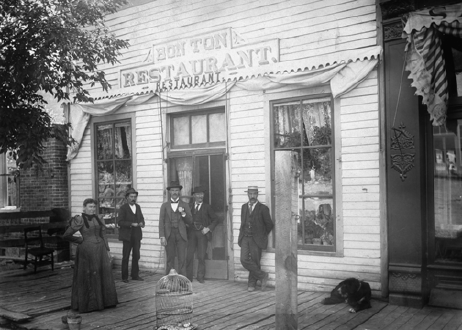
Photo: Denver Public Library, Western History Collection
More About This Topic
Restaurants were a good business in mining towns because miners were poor cooks. Many wrote home to their wives about how much they missed their cooking. They ate in restaurants whenever they could afford it. The Bon Ton Restaurant in Ouray was owned by Mrs. Kitty Heit, the woman at the left in the photo. She made enough money from the restaurant to build the St. Elmo Hotel in Ouray. This photo tells us that women, too, owned businesses in mining towns.
Tent Photo Gallery In Exchequer
This tent housed a photograph gallery in the mining camp of Exchequer. The sign in front says: Views of Bonanza, Exchequer, Sedwick & Round Mountain For Sale Here. These were mining towns in Saguache County north of Alamosa.
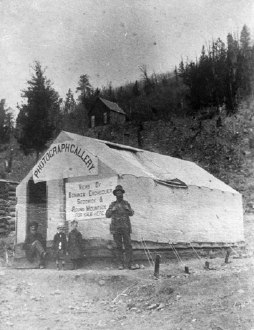
Photo: Denver Public Libray, Western History Collection
More About This Topic
Many mining towns had their own photographer. He took individual and family portraits in his studio. Some, like this photographer, also sold photos he had taken of nearby places. As mining camps sprang up, businesses of all kinds were housed in tents.
Their Own Words
“California Gulch in 1860 and 1861 had a population of something over 10,000 and was The Camp of Colorado. It was strung along through the gulch, which was something over five miles long, that is the mining part of it. There were a great many tents in the road and on the side of the ridge, and the wagons were backed up, the people living right in the wagons.”
Source: Wolfe Londoner, “Western Experiences and Colorado Mining Camps,” Colorado Magazine, 6 (March 1929): 69.
Secondhand Store In Cripple Creek
This second-hand store was located in Cripple Creek. The writing on the lower right corner says that a post office also was located in this cabin.
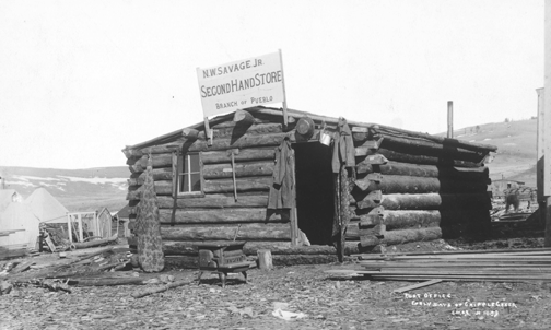
Photo: Denver Public Library, Western History Collection
More About This Topic
This second-hand store advertised its goods by hanging items on the wall in front. Take a close look at this photo. What items can you find that a miner might need?
Their Own Words
"The highlight of the day was the incoming mail. The post office was a log cabin, home-made pigeonholes for the letters, the papers frequently tossed into the fire, while hundreds of people waited in line for that letter from home."
Source: Mrs. A. H. Majors, "Pioneer Days in Crestone and Creede," Colorado Magazine, 21 (1944): 216-217.
Tent Lunchroom In Cripple Creek
The tent in this photo was a lunchroom in the town of Cripple Creek. The words written on the tent advertised the lunch menu.
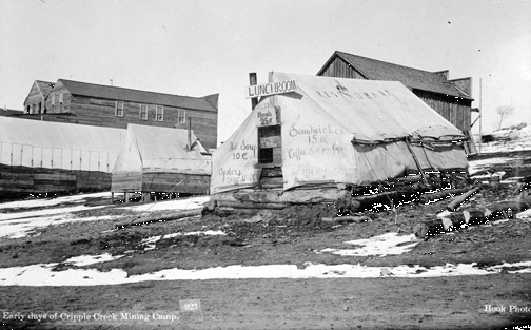
Photo: Denver Public Library, Western History Collection
More About This Topic
This lunchroom or restaurant was among the first businesses to open in the new mining camp of Cripple Creek. The menu written on the tent cover included: Hot Soup, 10 Cents; Oysters; Sandwiches, 15 Cents; Coffee 5 Cents Per Cup; and Hot Beef Hash, 10 Cents.
Their Own Words
“It was not so bad during the day but when darkness came and you could see the big tent-saloons illuminated, hear the music and knew there was light, warmth, entertainment and liquid refreshments to be had our footsteps invariably pointed to those places of diversion and enjoyment. . . .”
Source: Clayton Nickols quoted in Walker D. Wyman, “Grand Junction’s First Year, 1882,” Colorado Magazine, 13 (July 1936): 132.

